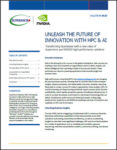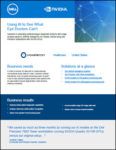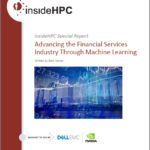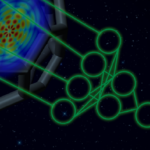NVIDIA has announced release 1.1 of its AI Enterprise software suite. It includes production support for containerized AI with the NVIDIA software on VMware vSphere with Tanzu, previously available only on a trial basis. NVIDIA said the update allows enterprises to run accelerated AI workloads on vSphere running in both Kubernetes containers and virtual machines, with […]
Unleash the Future of Innovation with HPC & AI
This whitepaper reviews how cutting-edge solutions from Supermicro and NVIDIA are enabling customers to transform and capitalize on HPC and AI innovation. Data is the driving force for success in the global marketplace. Data volumes are erupting in size and complexity as organizations work to collect, analyze, and derive intelligence from a growing number of sources and devices. These workloads are critical to powering applications that translate insight into business value.
Using AI to See What Eye Doctors Can’t
This white paper explains how Voxeleron, a leader in delivering advanced ophthalmic image analysis and machine learning solutions, is extending ophthalmology’s diagnostic horizons with image analysis based on artificial intelligence (AI) models, trained using Dell Precision workstations with NVIDIA GPUs.
Advancing the Financial Services Industry Through Machine Learning
As financial institutions look to be empowered through machine learning, they should first acknowledge the benefits, challenges, and considerations involved. Download the new insideHPC guide that is essential reading for anyone involved in the financial services industry, from those who are beginning to explore the potential of machine learning, to those looking to expand and maximize its use.
Accelerating Quantum Chemistry for Drug Discovery
In the pharmaceutical industry, drug discovery is a long and expensive process. This sponsored post from Nvidia explores how the University of Florida and University of North Carolina developed an anakin-me neural network engine to produce computationally fast quantum mechanical simulations with high accuracy at a very low cost to speed drug discovery and exploration.
Dell Builds Bracewell Supercomputer for Bionic Vision Research at CSIRO in Australia
Today CSIRO, Australia’s top science agency, announced deployment of a new Dell EMC supercomputer, kicking off a new generation of research in artificial intelligence. “This new system will provide greater scale and processing power we need to build our computer vision systems by optimization of processing over broader scenarios, represented by much larger sets of images, to help train the software to understand and represent the world. We’ll be able to take our computer vision research to the next level, solving problems through leveraging large scale image data that most labs around the world aren’t able to.” Assoc. Professor Barnes said.










